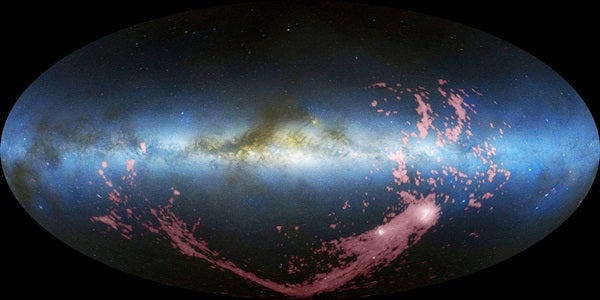The Large and Small Magellanic Clouds, two dwarf galaxies orbiting the Milky Way, are at the head of the gaseous stream. Since the stream’s discovery by radio telescopes in the early 1970s, astronomers have wondered whether the gas comes from one or both of the satellite galaxies. New Hubble observations reveal most of the gas was stripped from the Small Magellanic Cloud about 2 billion years ago, and a second region of the stream originated more recently from the Large Magellanic Cloud.
A team of astronomers, led by Andrew J. Fox of the Space Telescope Science Institute in Baltimore, determined the source of the gas filament by using Hubble’s Cosmic Origins Spectrograph to measure the amount of heavy elements, such as oxygen and sulfur, at six locations along the Magellanic Stream. They observed faraway quasars, the brilliant cores of active galaxies that emit light that passes through the stream. They detected the heavy elements from the way the elements absorb ultraviolet light.
Fox’s team found a low amount of oxygen and sulfur along most of the stream, matching the levels in the Small Magellanic Cloud about 2 billion years ago, when the gaseous ribbon is thought to have formed. In a surprising twist, the team discovered a much higher level of sulfur in a region of the stream that is closer to the Magellanic Clouds.
“We’re finding a consistent amount of heavy elements in the stream until we get very close to the Magellanic Clouds, and then the heavy element levels go up,” said Fox. “This inner region is very similar in composition to the Large Magellanic Cloud, suggesting it was ripped out of that galaxy more recently.”
“Only Hubble can measure these abundances,” Fox said. “These abundances can only be measured in ultraviolet light, which Earth’s atmosphere absorbs, and so the observations can only be done from a telescope in space.”
Unlike other satellite galaxies of the Milky Way, the Magellanic Clouds have been able to retain their gas and still form stars because they’re more massive than the other satellites. However, as they’re now approaching the Milky Way, they’re feeling its gravity more and also encountering its halo of hot gas, which pushes their own gas out. That process, together with the gravitational tug-of-war between the Magellanic Clouds, leads to the production of a stream.
Ultimately, the gaseous stream may rain down onto the Milky Way’s disk, fueling the birth of new stars. This infusion of fresh gas is part of a process that triggers star formation in a galaxy. Astronomers want to know the origin of that wayward gas in order to more fully understand how galaxies make new stars.
“We want to understand how galaxies like the Milky Way strip the gas from small galaxies that fall into them and then use it to form new stars,” Fox said. “This seems like it’s an episodic process. It’s not a smooth process where a slow stream of gas comes in continuously. Instead, once in a while a large gas cloud falls in. We have a way of testing that here,where two galaxies are coming in. We’ve shown which of them is producing the gas that ultimately will fall into the Milky Way.”










